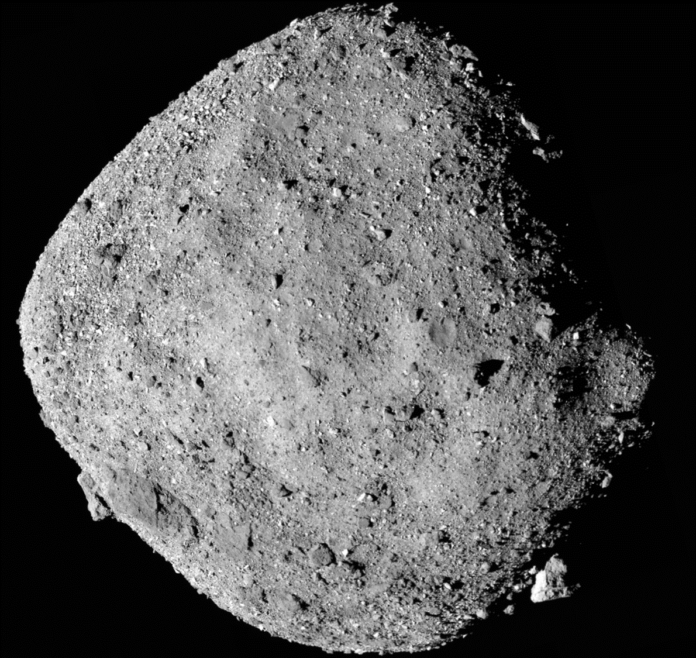When most folks imagine the asteroids, they likely picture chunk of rocky rubble, maybe mixed in with some metals based on distant observations and flybys. They shouldn’t be very complicated because they’re just leftovers from the formation of the solar system. Most of the meteorites that have been sampled on Earth have a lot of the same basic minerals and elements as well.
As it turns out, going out to the asteroid belt and directly sampling one of these primordial objects has turned that notion around. The pristine sample of Bennu, visited by OSIRIS-REx in 2023, is absolutely full of minerals that weren’t expected. And those minerals seem to suggest that Bennu — or more likely whatever its progenitor object was — may have been a lot wetter than we might have guessed.
A view of the exterior of the OSIRIS-REx sample collector, where stray bits of asteroid material from Bennu can be seen on the middle right; most of the sample is still sealed inside. (Credit: NASA/Erika Blumenfeld & Joseph Aebersold)
Water in Minerals
First, let’s talk about minerals! One of the ways we divide up minerals is by whether they are “hydrated” or not. This doesn’t mean that we break out the Gatorade or expect to find pockets of liquid water. This means that water is in the mineral. Quite literally, molecular water that is in the form (OH)- is an integral piece of the crystalline structure and formula. So, hydrated minerals like clays, micas and many more are chock full of “water”, but not in the way we might normally consider, well, wet.
Lots of the most common minerals in rocks that make up most rocky planets are not hydrated — they do not contain water in their mineral structure. However, if they find themselves somewhere that has a lot of usually warm, slightly acidic water — say, the bottom of the ocean at a mid-ocean ridge — these minerals can be changed to become hydrated minerals.
We call it hydrothermal alteration — water + heat = changed mineral. If the crystalline structure and constituent elements changes in a mineral, then you have a new mineral. So, take something like plagioclase, pyroxene and olivine, the most abundant minerals in basalt and all anhydrous (lacking water in their structure) and plop it for thousands to millions of years in a wet environment like an ocean floor. You likely end up with new hydrated minerals like chlorite, serpentinite, epidote and clays.
A scanning electron microscope image of phyllosilicate minerals (platy shapes) found in the sample returned from Bennu. Credit: Lauretta and others (2024), Meteoritics & Planetary Science.
Unexpected Returns
Alright, back to Bennu. Anew study published in Meteoritics & Planetary Science by Dante Lauretta and a host of others described the physical and chemical properties of the returned chuck of rock returned by OSIRIS-REx. The sample was expected to be carbon-rich (it was) and have lots of common anhydrous minerals (it did). However, what was unexpected was all the “phyllosilicates” (a fancy word for minerals built around the silicon that forms sheets like phyllo dough) and phosphates (minerals centered around phosphorus).
That’s weird, at least in terms of what we expected from a random chunk of asteroid. In order to create these kinds of hydrated and phosphorus-rich minerals, you need liquid water (at least based on our current understanding) like serpentinite and smectite clay. Hydrothermally altering your typical basalt will produce magnesium and calcium-rich hydrated minerals like those observed in the Bennu sample.
The capsule containing pieces of Bennu retrieved by NASA’s OSIRIS-REx mission sitting in the desert of Utah in September 2023. Credit: NASA.
On Earth, we find lots of minerals like these related to the circulation of seawater in the basalt rocks forming at the bottom of the ocean. Similarly, phosphates tend to form from evaporating bodies of water. We find them in salt flats on Earth, such as the one where the Bennu sample landed. So, water is likely needed for those as well.
Lost Ocean World?
However, things are complicated. You likely can’t have a body of liquid water on an object as small as Bennu as it’s only half a kilometer in diameter. So, maybe the parental object that broke apart was a very wet world before it met its unseemly demise. Maybe it could have even be considered an “ocean world” like Enceladus?
There is likely only so much that we can conclude about this long-lost proto-planet from the 120 gram sample (roughly the mass of a banana) brought back to Earth. We had an inkling that Bennu had some hydrated minerals based on remote data. However, many of these discoveries, such as the phosphates and specific minerals, would not have been possible without actually going to Bennu and bringing pieces back.
That’s what makes sample retrieval so important and exciting! We can do all sorts of analyses at very high levels of detail on Earth that just can’t be replicated (today) by sending robots. Those robots are great for getting the “big picture” (which can sometimes still be quite detailed), but bringing stuff back to Earth for humans to examine really helps us expand our knowledge of the solar system and its origins.
Source : Discovermagazine






